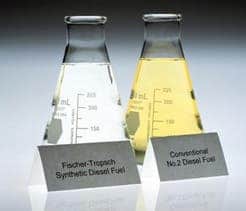Over the past few years, a series of papers looked on how the United States could benefit by switching from crude oil to alternative synthetic fuels. Their findings show that, given the current economic environment where oil prices have simply skyrocketed, synthetic fuels are more advantageous compared to crude oil from a number of perspectives, including environmental.
Synthetic oils are chemical processed hydrocarbons made from various feedstock like coal, natural gas and non-food crops. The resulting products include fuels, waxes and lubricants normally made from crude oil. Actually plants can produce gasoline, diesel and aviation fuels at competitive prices, depending on the price of crude oil and the type of feedstock used to create the synthetic fuel, all with the same or similar performances of those derived from crude oil.
This means that motor vehicles can run without issues on synthetic fuels without the need for complicated addons or new specifically designed engines, like ethanol, a biofuel, requires.
Lowering greenhouse gas emissions with synthetic fuels

Because refineries, extraction facilities and non-edible crops would have to be integrated in a newly build infrastructure, an enormous social and economic impact could potentially unfold. Millions of jobs would open and the country wouldn’t have to import oil or resort to unorthodox extraction methods (see wars). Moreover, since plants absorb carbon dioxide to grow, the United States could cut vehicle greenhouse emissions by as much as 50 percent in the next several decades using non-food crops to create liquid fuels, the researchers said.
“The goal is to produce sufficient fuel and also to cut CO2 emissions, or the equivalent, by 50 percent,” said Christodoulos Floudas, a professor of chemical and biological engineering at Princeton, who led the research. “The question was not only can it be done, but also can it be done in an economically attractive way. The answer is affirmative in both cases.”
Synthetic fuels make for an important chapterof a white paper recently produced by the American Institute of Chemical Engineers (AIChE) and authored by Vern Weekman, one of Floudas’ co-researchers.
“Right now we are going down so many energy paths,” said June Wispelwey, the institute’s director and a 1981 Princeton alumna. “There are ways for the system to be more integrated and much more efficient
The struggles that come with transitioning to synthetic fuels
The main synthetic fuel production method employed today is the Fischer-Tropsch process, first developed in the 1920s in Germany out of the need to convert coal into liquid fuels. The process involves heat and a complicated chemistry to create gasoline and other liquid fuels from high-carbon feedstock ranging from coal to switchgrass, a native North American grass common to the Great Plains.
“This is an opportunity to create a new economy,” Floudas said. “The amount of petroleum the U.S. imports is very high. What is the price of that? What other resources to do we have? And what can we do about it?”
If synthetic fuels hold so many benefits, why isn’t the US or other countries in the world use them at a mass scale? As with all things – cost. Experts estimate that an investment of $1.1 trillion would be required for a synthetic fuel infrastructure to be developed. Also, an expected 30 to 40 years transition period would have to pass before the U.S. would be capable of fully embracing synthetic fuels.
Why not start now? This is exactly what the researchers are striving for, and the white paper published by the AIChE is particularly addressed to key national planning agencies like the national academies, the Department of Energy, the Environmental Protection Agency, the Defense Department.
“Even including the capital costs, synthetic fuels can still be profitable,” said Richard Baliban, a chemical and biological engineering graduate student who graduated in 2012 and was the lead author on several of the team’s papers. “As long as crude oil is between $60 and $100 per barrel, these processes are competitive depending on the feedstock,” he said.
The paper was published in the AIChE Journal.
[source Princeton]


